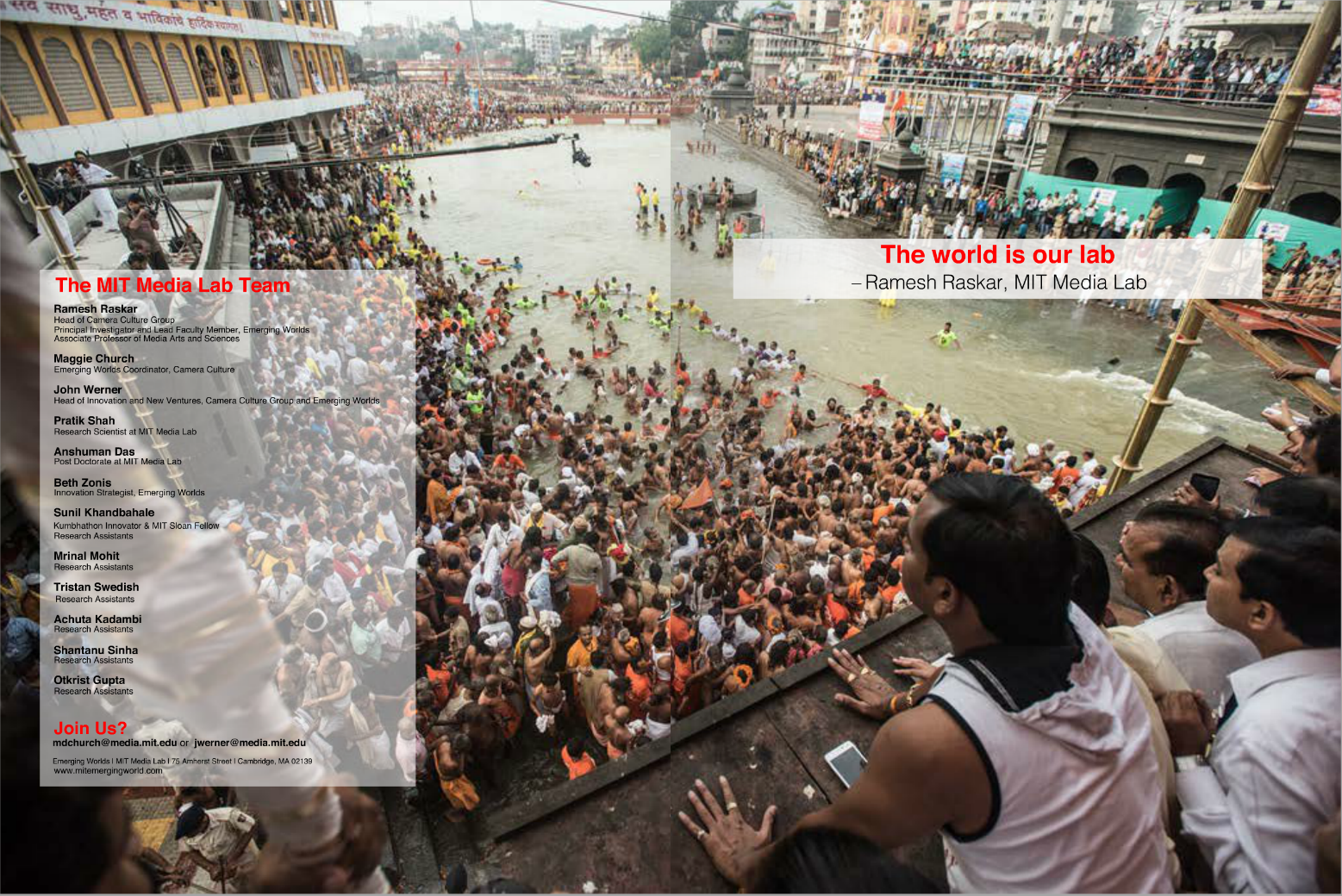MIT @Kumbh Mela: Deploying Innovations for Impact
The Kumbh Mela is a colorful, beautiful event. It’s a massive religious festival, a pilgrimage. In August and September 2015 30 million visitors – people from all walks of life – came to Nashik, India in 30 days. Sadhus who have very unusual lifestyles descended on pilgrimage sites. There was a lot of work to do to prepare for millions of people to show up in this relatively small and sleepy city of two million people.
The Kumbh Mela was a natural catalyst to bring people together to innovate for impact. It presented a unique opportunity to design, build and roll out solutions, with the goal of making the Kumbh Mela safer, cleaner, and more efficient than ever before. The innovation teams worked hard with this goal in sight.
By all accounts, this Kumbh Mela was a resounding success. There were zero casualties, zero missing cases, and zero disputes. Now, Nashik is increasingly seen as an innovation hub with year-round innovation activities.
Bottom-up Co-Innovation
At the MIT Media Lab, we look beyond the obvious to ask the questions not yet asked – questions whose answers could radically improve the way people live, learn, work, and play. The world is our lab – to create, test, refine and deploy solutions to the world’s problems.
In the summer of 2015, at the Kumbh Mela festival in Nashik India, we were able to directly influence the deployment of solutions to impact billions. This is the culture of innovation in action.
– Dr. Ramesh Raskar, MIT Media Lab
Kumbhathon @Nashik: A Year Round Innovation Platform
Inspired through brainstorming about social challenges and how local human capital could solve them, Professor Ramesh Raskar of the MIT Media Lab initiated week-long innovation camps or “buildathons” in India. In July 2013, the team ran their first camp in Hyderabad, India. In January 2014, they ran one in Mumbai. In July 2014 they ran their first camp in Nashik, Ramesh’s hometown.
The program in Nashik came to be called “Kumbhathon.” Prior to the Kumbh Mela in 2015, the MIT team ran 5 Kumbhathon camps or workshops in Nashik to accelerate idea creation, development and deployment.
For almost two years, the MIT team and Kumbhathon innovators worked closely with members of the broader ecosystem. Elected government officials and administrators in the City of Nashik were particularly critical to the success of the Kumbhathon and the Kumbh Mela. They helped to identify and refine Kumbhathon challenges that were of high priority to its citizens. They provided access to data, guided the development of prototypes, and facilitated the implementation on the ground, in context.
At Kumbhathon5 (the fifth Kumbhathon) in July 2015, teams worked with increasing sense of purpose to finalize their prototypes and prepare to launch them. In August, several were ready and able to be deployed “live.” The solutions addressed many of the government’s key concerns: safety, hygiene, health, food distribution, navigation and transportation, and accommodation.
The Kumbhathon is an opportunity for teams of engineers, business people and designers in order to create together with local stakeholders. Teams collaborate with government officials to understand local needs and get access to necessary data; with local academics to learn and refine their skills; with business leaders to consider market rollout; and with MIT researchers to make the solutions technically robust.
Solutions Launched @Kumbh Mela
These inventions can scale quickly, they are applicable to other environments, and they helped make this Kumbh Mela the safest on record.
The Official Kumbh App
A repository of Kumbh details, such as real-time crowd flow, transportation and parking, news, availability of hospital beds, hotels, restaurants, schools, universities and temples.
Crowd Steering
A real-time system that uses heat maps to show density distribution of large crowds and their flow, allowing city administrators to redirect people away from saturated areas.
MediTracker
A dynamic, real-time information system about hospitals, medical centers, bed availability that also provides navigation for quick access to ambulances and healthcare providers.
Annadan
An optimized supply chain for donated and homemade food that empowers home cooks and distributes food to those who need it where and when they need it.
Pop-up Housing
Temporary housing made of low cost, reusable industrial materials such as pallet racks, that can be assembled in less than 3 days.
ASHIOTO
A real-time centralized dashboard collects footstep counts from multiple mats and displays crowd data on mobile phones. Data enables authorities to redirect crowds and avoid stampedes.
EpiMetrics
A system to monitor the health status of people in real time, in order to control disease outbreaks.
3D Maps
A dynamic, real-time smart phone-friendly digital map that can be customized for ongoing events, dates, languages and promotions.
MIT @Kumbh Mela: Deploying Innovations for Impact
The Kumbh Mela is a colorful, beautiful event. It’s a massive religious festival, a pilgrimage. In August and September 2015 30 million visitors – people from all walks of life – came to Nashik, India in 30 days. Sadhus who have very unusual lifestyles descended on pilgrimage sites. There was a lot of work to do to prepare for millions of people to show up in this relatively small and sleepy city of two million people.
The Kumbh Mela was a natural catalyst to bring people together to innovate for impact. It presented a unique opportunity to design, build and roll out solutions, with the goal of making the Kumbh Mela safer, cleaner, and more efficient than ever before. The innovation teams worked hard with this goal in sight.
By all accounts, this Kumbh Mela was a resounding success. There were zero casualties, zero missing cases, and zero disputes. Now, Nashik is increasingly seen as an innovation hub with year-round innovation activities.













